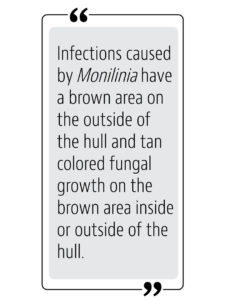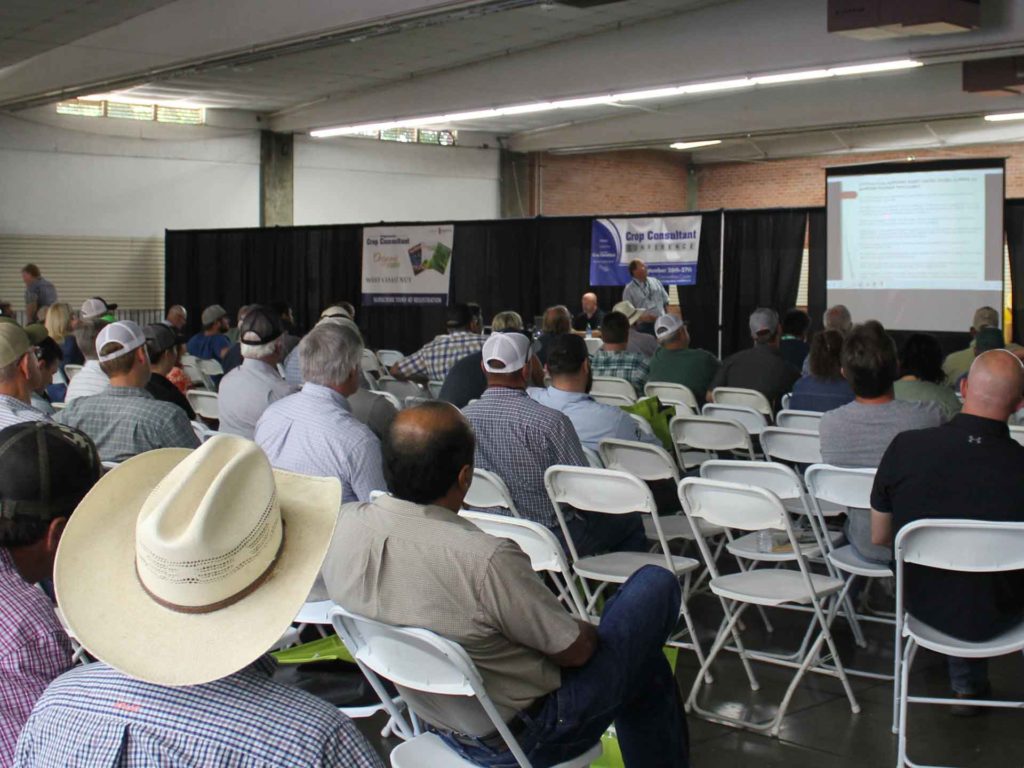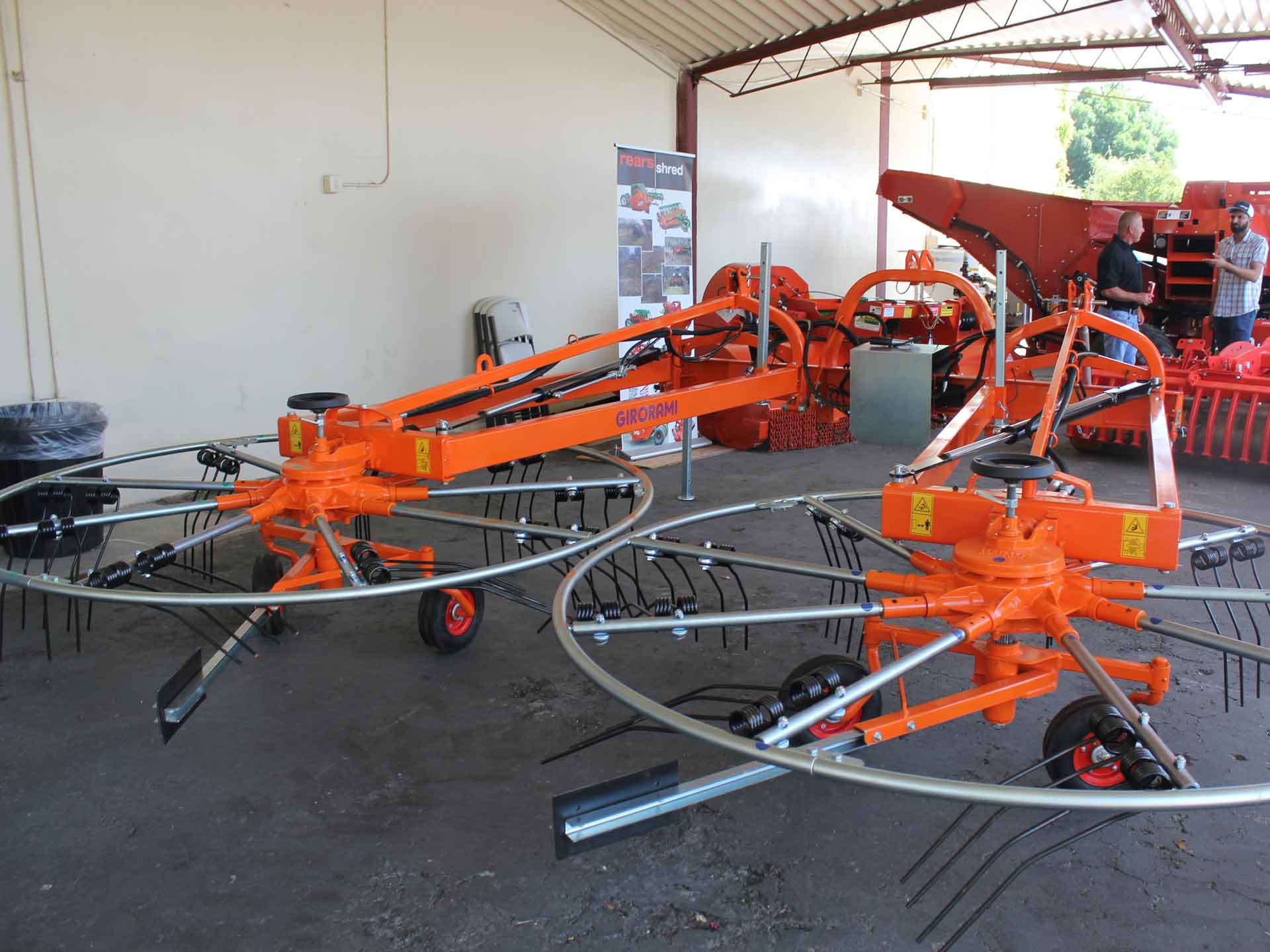Prevention of a fungal disease that can affect almond yields for many growing seasons starts with a correct diagnosis and understanding of disease biology.
Hull Rot
Almond hulls are susceptible to hull rot fungi from the beginning of hull split until the hulls are dry. This period can last from 10 days to two months depending on the irrigation and fertilization management of the orchard. There are no control measures once hull rot infections are visible. University of California (UC) Riverside plant pathologist Jim Adaskaveg identified the ‘deep V’ stage of hull split as the stage when almonds are most vulnerable to hull rot infections.
Dr. Mohammad Yaghmour, University of California Cooperative Extension (UCCE) farm advisor for almonds in Kern County is conducting research to determine control measures for hull rot. He was one of the seminar speakers at Almond Day in June and outlined best management practices and treatment for hull rot in almonds.
Disease Development
Withered and dead leaves on a shoot are an indication of hull rot infections in almond trees. Examination of the fruit from that shoot will show a brown area on the outside of the hull and either tan or black colored fungal growth on the inside of the hull. The fungal growth in the hulls produces a toxin that kills the spur and eventually the shoot. The disease causes dieback of shoots and fruiting wood that reduce productivity in subsequent years. Nuts on affected shoots may be difficult to remove at harvest.

The major factors in disease development, Yaghmour said, are susceptibility of the rootstock and or scion, presence of an aggressive pathogen and a favorable environment for the pathogen. Integrated Pest Management (IPM) strategies for disease prevention include resistant varieties and rootstocks, irrigation and fertilization management and disease models and forecasting. Successful control strategies may vary by soil types and location.
Susceptibility by Variety
In almonds, susceptibility to hull rot varies with variety, and Nonpareil is one of the varieties listed as most susceptible. According to the UC IPM web site, the most susceptible important almond varieties also include Monterey, Sonora, Fritz and Winters. The hard shell varieties Mission, Davey and Drake may have rotted hulls but rarely shoot dieback.
Confusing Symptoms
Symptoms of hull rot can be confusing, Yaghmour told growers at Almond Day. The two primary pathogens have been Rhizopus stolonifer and Monilinia, however in 2017, Yaghmour confirmed that Aspergillus niger induced hull rot was found in Kern County.
Infections caused by Monilinia have a brown area on the outside of the hull and tan colored fungal growth on the brown area inside or outside of the hull. R. stolinifer infections are identified by black fungal growth on the inside of the hull between hull and shell. A. niger infections are identified by flat, jet black spores between hull and shell.
Yaghmour, who has been doing research on A. niger, said it has now been found in many almond producing counties in the San Joaquin Valley. His studies showed that A. niger produced hull rot symptoms in field inoculations and the highest spore populations on fruit were found later in the growing season on fruits with less than 3/8 inch hull split. In the first year of the study, inoculated fruit with hull split less than 3/8 inch had the highest percentage of spurs with disease symptoms.
Nitrogen
Yaghmour said hull rot incidence increases with increased nitrogen (N) application rates. Between 125-200 pounds per acre of applied N, the percentage of infected spurs increased depending age of the spur. Excess N applications 45-60 days prior hull split should be avoided. Leaf samples taken in July should be below 2.6 percent to avoid hull rot.
UC studies showed that trees receiving nitrogen at applications rates above 250 pounds per acre were the most severely affected by hull rot. Hull rot strikes were higher in low crop years. Reducing application rates based on crop load and analysis of leaf nitrogen content is advised. The critical value for mid summer leaf nitrogen percentages is 2.2-2.5 percent.
Nitrogen should not be applied after kernel development is completed. This is typically in late spring, but in abnormal years, it may extend into early summer. Applications made after this point will be directed to the hull, making the hull more conducive to infection. Nitrogen applications can resume in the post harvest period. Data suggests that nitrogen source does not influence hull rot.

Irrigation Management
Irrigation management is another tool to prevent hull rot. UC research has shown deficit irrigation decreased incidence of hull rot and regulated deficit irrigation was more effective than sustained deficit irrigation.
Irrigation should occur when the stem water potential is four bars below baseline, usually -14 and -16 bars, depending on weather. Deficit irrigation should be carried out for two weeks, and full irrigation should resume until harvest dry-down. Duration of the irrigation should be reduced, not the frequency. Typically, a 10-20 percent reduction in applied water will be needed, depending on soil and irrigation system. A properly timed and applied deficit can reduce hull rot by 80-90 percent and synchronize and advance hull split without affecting yield or kernel size.
Chemical Control
Chemical control of hull rot caused by R. stolonifer and Moniliania spp. depends on timing. Infections due to R. stolonifer can be managed by a single fungicide application at hull split (1-5 percent). The application can be timed with a navel orangeworm insecticide treatment. Hull rot caused by Monilinia spp. is best managed with a fungicide application three to four weeks prior to hull split, usually early June. Efficacy chart for fungicides can be found at the UC ANR IPM web site.
Disease Biology Research
Yaghmour is currently conducting research to study disease biology and factors that contribute to A. niger and disease development. He plans to complete pathogenicity tests and to study almond susceptibility, assess disease incidence and to monitor inoculum dispersal in the orchard. Further studies on the effect of nitrogen will also continue.
Findings from the 2018 trials include significantly higher natural incidence of hull rot in the northern trial plot. Spurs with hull rot symptoms were collected and fruit evaluated for A.niger and R. stolonifer and mixed infections. Yaghmour said when looking at each block within the orchard, the northern plot had higher percentage of fruit infected with A. niger while the southern plot had higher R. stolonifer infections compared to the northern plot.

Cecilia Parsons
Cecilia Parsons has lived in the Central Valley community of Ducor since 1976, covering agriculture for numerous agricultural publications over the years. She has found and nurtured many wonderful and helpful contacts in the ag community, including the UCCE advisors, allowing for news coverage that focuses on the basics of food production.
She is always on the search for new ag topics that can help growers and processors in the San Joaquin Valley improve their bottom line.
In her free time, Cecilia rides her horse, Holly in ranch versatility shows and raises registered Shetland sheep which she exhibits at county and state fairs during the summer.
















